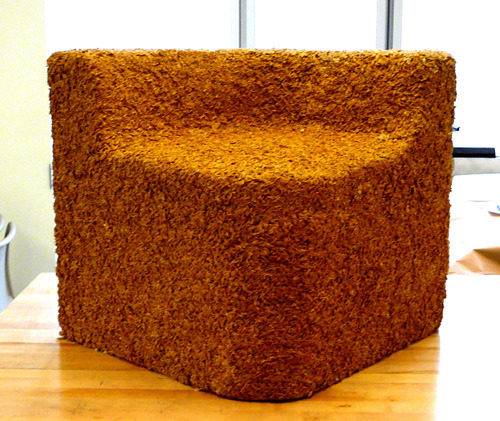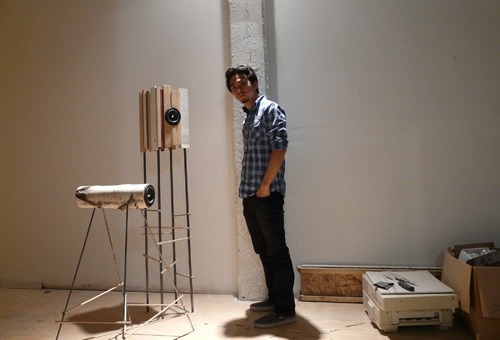Con Edison Immigrant Artist Program Newsletter, Issue No. 23
Featured Artist: Stanley Ruiz
This month’s featured artist is Stanley Ruiz, a Filipino-born industrial designer living and working in Brooklyn. In his works, he fuses the industrial with the natural to bring about new meaning and interpretation to familiar object archetypes. Ruiz’s designs are characterized by a raw yet modern aesthetic, reflecting folk influences while utilizing handicraft production techniques. Sustainability is an important factor that he addresses in his work. The below interview was conducted by IAP Program Officer Karen Demavivas. To visit Ruiz’s website, please click here.
IAP: Can you share how some folk influences and agricultural resources (such as rice) from your native Philippines inform your raw, modern aesthetic?
SR: Some of the materials I work with are chosen for their nostalgic connection to my childhood and my home land. I use these raw, folk, basic materials such as twigs and stones as “memory triggers.” The hope is that the viewer will relate to the object more once he/she sees it, drawing a connection to their own experience. I’ve been exploring rice recently and looking for ways to incorporate the material in my designs. Rice is very symbolic of my culture, and I’d like to use it as part of my design vocabulary, mainly for the meaning associated with it. The overall aesthetic is ultimately dictated by the materials that I use.

IAP: You are a supporter of socially responsible community-based crafts, can you share some of the ways you have addressed and continue to address sustainability in your work?
SR: Early in my career, I was a consultant for a Fair Trade organization in the Philippines. I’ve collaborated with village artisans and micro-industries to produce crafts-based products, mostly by using indigenous materials like coconut, bamboo, abaca, rattan, and shell, among others. It is important to note that in an agricultural economy, cottage industries provide livelihood to a significant number of people. Sustainability is a sensitive topic, and I define it as making use of resources we have while making the same resources available for future generations. Whenever I have control over production, I would specify natural materials that can be replenished quickly, like bamboo or any palm reeds. This is more crucial when it comes to commercial production, where volume is higher. In my independent practice, this has been a challenge, since I have limited access to natural materials here. What I do is I try to combine found natural artifacts like fallen branches, twigs, stones, and other waste products like rice husks, with off the shelf industrial materials like steel and wood.
IAP: Can you comment on the eco-design movement that is growing globally? For example, the eco-design company Osisu in Thailand is revolutionizing furniture design in Southeast Asia by innovatively combining recycled industrial materials with traditional woodwork. Are there other leading examples from the Asian contexts you’ve worked in?
SR: Yes, eco-design has been consistently growing. I think the greatest achievement of the eco-design movement of recent years is that it was able to break through the mainstream media. There is more awareness now than in the past decade or so. However, to give credit to the pioneers, we need to realize that this eco-consciousness has been around for several years now. Crafts-based manufacturers in Southeast Asia have been exporting “green” products since the 70’s. Parallel movements have been seen in Latin America and Africa. I’ve seen many examples of eco-material innovation in Asia – from bags and accessories made of recycled juice packaging, vases from newspapers, jewelry from shells, etc… to more “industrial craft” process innovation by the likes of Singgih Kartono (Java, Indonesia), and Kenneth Cobonpue (Cebu, Philippines).
IAP: You are now based in Sunset Park, Brooklyn, which has a prominent Asian, mostly Chinese, immigrant community. Does living in this area influence your work and the way you view yourself as an immigrant and creative producer in New York? If so, how?
SR: Living in my neighborhood probably doesn’t influence my work directly. At least I haven’t thought of it that way yet. However, living in an Asian community makes my life a lot easier due to the availability of familiar food and other goods, which contribute to my well-being. It makes me feel comfortable knowing I can get a rice meal within a 2 block radius! I think living in Sunset Park impacts me more on a “multiple culture-integration” level – meaning I have to first integrate as an immigrant in the US on a macro level, and then secondly, I have to integrate with my co-immigrants in a micro level (or vice-versa).
IAP: In New York, you have been gaining momentum and recognition for your work with the exhibitions “Home Front: American Design Club” at the Museum of Arts and Design and “Re: Design” at the Visual Arts Center of New Jersey this spring; as well as an exhibition at The Vilcek Foundation scheduled for next year. In your opinion, can you share what design qualities and other factors compel these institutions to engage with your work?
SR: I feel that by taking a less common and less predictable approach, I was able to differentiate my practice and develop my own design vocabulary. I think my cultural background and life experience are factors too, as well as my unapologetically lo-fi approach to product design.
IAP: Do you have professional advice for other immigrant designers who wish to engage with the NYC design world?
SR: I would encourage them to spend some time honing their craft and creating something special, then connect to the world by showing their work through exhibitions. Be bold, be prolific, and support your peers and the design community. A thriving design scene will bring about more opportunities for everyone.




